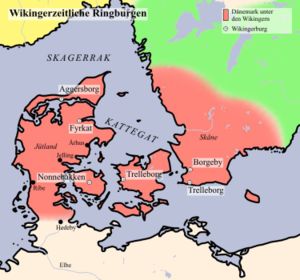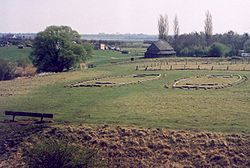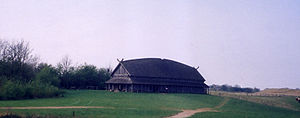.gif)
Trelleborg (Slagelse)
Encyclopedia

Slagelse
Slagelse, a town in east Denmark, is in Slagelse municipality on the island of Zealand. It is about 100 km southwest of Copenhagen. The population is 31,979 ....
on the Danish
Denmark
Denmark is a Scandinavian country in Northern Europe. The countries of Denmark and Greenland, as well as the Faroe Islands, constitute the Kingdom of Denmark . It is the southernmost of the Nordic countries, southwest of Sweden and south of Norway, and bordered to the south by Germany. Denmark...
island of Zealand is one of the Viking ring castles
Viking ring castles
Trelleborg is a collective name for six Viking Age circular forts, located in Denmark and the southern part of modern Sweden. Five of them have been dated to the reign of the Harold Bluetooth of Denmark...
of which five or six have been found until now (2006). It lies to the northwest of Slagelse. At the time the fortress was built it was situated on a peninsula that jutted into the swampy area between two rivers. It was connected to the Great Belt
Great Belt
The Great Belt is a strait between the main Danish islands of Zealand and Funen . Effectively dividing Denmark in two, the Belt was served by the Great Belt ferries from the late 19th century until the islands were connected by the Great Belt Fixed Link in 1997–98.-Geography:The Great Belt is the...
by a lake that at its time was usable for Viking ships, but that has since vanished. It might have commanded the connection to the island of Fyn
FYN
Proto-oncogene tyrosine-protein kinase Fyn is an enzyme that in humans is encoded by the FYN gene.This gene is a member of the protein-tyrosine kinase oncogene family. It encodes a membrane-associated tyrosine kinase that has been implicated in the control of cell growth...
and the sea traffic on the Great Belt.
Layout and construction
Similar to the other Viking ring castles found so far, the Trelleborg at Slagelse was designed as an exact circle with two roads that crossed at right angles in the geometric center and led to the four gates with two always opposite to each other. In each of the four quarters stood four almost identical longhouses arranged in a square. Unlike the others, the fortress was extended with a sort of baileyWard (fortification)
In fortifications, a bailey or ward refers to a courtyard enclosed by a curtain wall. In particular, an early type of European castle was known as a Motte-and-bailey. Castles can have more than one ward. Their layout depends both on the local topography and the level of fortification technology...
. The whole fortress may have supplied room for some 1,300 people.


Main castle
The circular main castle was surrounded by a 5-meter-high rampartDefensive wall
A defensive wall is a fortification used to protect a city or settlement from potential aggressors. In ancient to modern times, they were used to enclose settlements...
that was 17.5 meters wide at the base and had a diameter of 137 meters. The outer walling was made of oak. Two rows of poles were supported by slanted beams from the outside and the room in between the poles was filled with loam and stones. The inside was also clad with wood, the two facades were reinforced by beams connecting the two. In the east there was a 5-meter-broad berm protected by a ditch with a pointed profile, 17 meters wide and 4 meters deep. The ditch was not filled with water and had a palisade at its base. The two roads were covered with wood, and the four gates lined with stones on the inside. As in Fyrkat, there may have been a circle path along the inner side of the ramparts.
The 16 longhouses were arranged in four squares 29.42 meters long each and had a somewhat ship-like form, the long walls bulging outwards. Each house was divided into three rooms with a large central hall (18 x 8 m) and two smaller rooms at the ends. Each house had four entrances, two at the short ends and two in the long walls. The doors where protected by porches. Besides the large longhouses there were also smaller houses to the north of the north eastern quarter, two small houses in the inner yard of the northeastern and southwestern quarter and a little square hut each near the northern and western gates.
Bailey
This part of the fortress seems unique, as the other fortresses seem to lack this feature (so far only Aggersborg, Fyrkat and the Trelleborg near Slagelse have been fully excavated as of 2006). The bailey was protected by a rampart of its own to the east. The 15 longhouses of the bailey, each 26.33 meters long, were placed with their axis through the length of the buildings pointing to the center of the main castle.In an extension of this bailey was a cemetery with 135 graves. Most buried were young men but some were also women or children. Two contained mass burials, one for five and one for eleven persons. Over two-thirds of the graves had no grave offerings, the others only had few pieces, weapons being rather rare. Only two graves were rich in items. One was a woman's grave with pearls, a bronze bucket, a wood casket and game stones. The other was the grave of a male with a bronze bowl and a silver adorned axe. The large amount of simple graves may indicate a Christian influence. Graves of horsemen were found on surrounding higher grounds.
Excavation and finds
The site was excavated from 1934 to 1942. Most of the finds were things of every day life: pottery, locks, keys, fittings, knives, whetstones, combs, weaving weights, scissors and needles. Weapons such as iron axes, arrow points and parts of shields.Dating
Older datings put the castle near the year 1000. Datings by DendrochronologyDendrochronology
Dendrochronology or tree-ring dating is the scientific method of dating based on the analysis of patterns of tree-rings. Dendrochronology can date the time at which tree rings were formed, in many types of wood, to the exact calendar year...
have found the wood used for the construction to have been felled in the fall of 980 and thus being used for building presumably in the spring of 981. The rather short construction time and the complete lack of any signs of maintenance indicate an only short use of the buildings. Possibly the fortress was abandoned before it was completed. Signs of fire may indicate its destruction by fire. The regions around the gates show signs of longer usage though.

